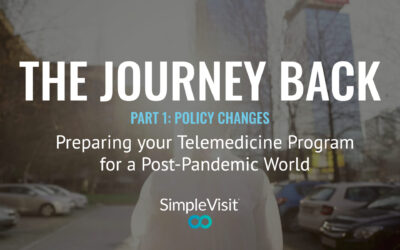
Lessons in Virtual Urgent Care
› 101: The Business of Telemedicine
COURSE OBJECTIVE: Over the next few weeks, we will introduce some lessons in an effort to educate professionals in urgent care space on the business value of including telemedicine into their practice. The first lesson is an orientation on the current landscape of the industry and projections as this space develops in the coming years.
The Urgent Care Market
It is no secret that Urgent Care clinics are increasing in popularity. Even though Merriam-Webster only added the term “Urgent Care” to the dictionary in 2017, this mode of healthcare has been taking off in the past decade. Between the years 2008 to 2015, studies show that visits to urgent care clinics increased by 119%. Another study saw utilization for urgent care clinics grow by 1725% from 2007 to 2016. And at the beginning of 2018, the Urgent Care Association of America (UCAoA) stated that the $18 billion dollar industry is predicted to grow 5.8 percent that year(1).
Let’s identify some key factors that contribute to this over-saturation of the Urgent Care market. Doctors moving to urgent care seem to be motivate by this overarching, often unspoken problem: physician burnout.
According to new research, the country’s physician burnout rate is alarmingly high at 43.9%, compared to workers in other industries. Urgent care can be a solution to some of the burnout causes. Providers are able to prioritize patient care – avoiding certain time-consuming corporate activities associated in other care environments. Rather, their time can be better spent focusing on the reason behind the practice of medicine as a whole – helping people become and stay healthy.
When working in an urgent care clinic, providers carry a different workload, and patients have very different expectations compared to their primary care physician. There is no caseload to manage. There is much less need for on-call or after-hours work that takes doctors away from their lives. The lack of providers being able to take care of themselves and their families is one of the main contributors to burnout.
Lastly, providers can have the satisfaction of resolving their patient’s immediate needs. In this consumer-focused health care market, which is characterized by availability of public data on healthcare entities of all kinds and price transparency for all related companies, those needs are easily met by urgent care centers that are able to cater to those consumer expectations of service, ease and cutting edge technology. Happy patients equal happy doctors.
For patients, the reasons for choosing urgent care are simple: it saves time, money and lives.
Time
The UCAoA found in 2018 that 94% of patients wait less than thirty minutes to see a provider in an urgent care. (2) Most current owners of Urgent Care clinics agree: “The average waiting time here is about 15 minutes or less on a busy day.” says Dr. Nabil Salib, owner of MYDOC urgent care (3). It would make sense that consumers would opt to visit an urgent care with a short wait time, compared to wait times in Emergency Departments. According to a recent study, the top two reasons patients choose urgent care clinics are because they think it will “take less time to be seen and treated” (22%) and because the location was more convenient for them (21%). Of 134.9 million ED visits in 2015, 64.6% had to wait longer than fifteen minutes – and only 9% resulted in a hospital admission. (4) While it doesn’t mean that the other 91% were not true emergencies, it’s relatively safe to say that many of those patients could have gone to an urgent care center, which typically have basic facilities such as EKG and X-ray machines, blood and fluid collection laboratories, and IV fluids/medications. Some even have pharmacies on site. The average length of time that people spend in the emergency department nationwide, from arrival to discharge or admissions, is two hours and fifteen minutes. However, the average waiting time varies state by state, with some states reporting average stays in the emergency department of 3 hours or more (5). Conversely, in urgent care clinics, 85% of patients have a total visit time of ninety minutes.
Money
In a 2017 study published in the Annals of Emergency Medicine, researchers found that the average price per visit at urgent care centers in 2015 was $168, while in emergency departments it was $2,259. The costs for services for patients with the same 20 most common diagnoses were almost 10 times higher at emergency departments than at urgent care centers. Because of this, more than anything else, one study found that the growth of patient utilization of urgent care increased seven times faster than emergency department utilization.
Lives
The American College of Emergency Physicians found that Patients who need to be seen in 1 to 14 minutes are being seen in twice that timeframe (37 minutes) in emergency departments (6). In 2012, a study was published in the Annals of Emergency Medicine that stated that “Patients who were admitted on days with high ED crowding experienced 5% greater odds of inpatient death” than similar patients admitted to the same hospital when the emergency department was less crowded (7). Given that, according to Urgent Care Association of America’s “2018 Benchmarking Report,” only 2% of patients who come to an urgent care center need to be diverted to an emergency department. That is enough of a reason in and of itself to go to an Urgent Care center.
Urgent care clinics currently see about 89 million patient visits each year! (8) The number of existing clinics went from 6,100 in 2013 to 8,285 as of June 2018 – that’s over 2,000 new businesses in 5 years alone.
The Telemedicine Market
There is another sector of healthcare that is fast gaining popularity right alongside urgent care: telehealth. In 2017, HIMSS research showed 71% of providers are using telehealth to connect with their patients.(9) In the 2018 Telemedicine Benchmark Survey by REACH Health, researchers found that:
- 70 percent of respondents view telemedicine as a top or high priority.
- A majority of organizations plan to increase or maintain investments in telemedicine.
- Improving patient outcomes was one of the two top objectives for telemedicine programs cited by respondents.
- Improved patient satisfaction was the most cited contributor to ROI, consistent with the past few surveys. (10)
Including telemedicine in a medical practice offers improved access, which means potential for more patients. The option of telemedicine also offers improved patient engagement and satisfaction, which dramatically increases the likelihood of future business.
Telemedicine also saves money and time. According to one telehealth and insurance company’s averages, a typical telehealth appointment costs $45, while a typical office visit can range from about $120 to $125, an urgent care visit is close to $175, and it can cost more than $1,000 for a single visit to the emergency room. Optum Behavioral Health reported in 2018 that their newly-established Virtual Visits program was yielding some great results. Clinicians can provide patients with an appointment 20% faster for a video visit than for an in-person session. Not only that, they found that offering telehealth may result in as much as a 60% decrease in missed appointments, as well as a 25% reduction in hospitalization rate and lengths of stay. Time and money.
Convenience is a highly favorable aspect of telehealth also. A majority of consumers in a recent survey reported that not having to leave the comfort of their own home was the biggest advantage of using telehealth services.
While anything new in the world of medicine seems like it can take forever to catch on, telemedicine adoption is increasing, among patients and providers alike. In 2013 there were only 350,000 users of telemedicine; with the rate of growth since then, in 2018 it was expected that that number would hit about 7 million. (11) Even employee health plans, notoriously slow at adopting anything remotely innovative for the sake of their subscribers, are jumping on the bandwagon. In their 2018 Employer Health Benefit Survey, Peterson-Kaiser stated that, “we see that among large employers offering health benefits, the share of firms whose plan with the largest enrollment covers telemedicine has increased steadily each year from 27% in 2015 to 74% in 2018.”
Urgent Care + Telemedicine = Exponential Growth
Taking the numbers above, we can apply them to the classic logic equation “if a and b, then c”. Urgent care growth and telemedicine both address the same major shifts in the healthcare consumer market; therefore combining the tools of telemedicine in an urgent care environment will yield exponential growth!
Consider this:
- In 2016, the size of global telemedicine market was valued at $20.58 billion and it is expected to be valued at $81.51 billion by 2024. (12)
And if that’s too far off in the future, Becker’s Hospital Review discovered that:
- The total telehealth market is predicted to grow by 14.3 percent by 2020 and be valued at $36.2 billion. In 2013, the market value was $14.3 billion.(13)
Including telemedicine services for urgent care practice not only makes sense, it will become necessary if the above-mentioned trends continue. Surviving in the current healthcare market requires constant innovation through and adaptation to the newest technology frontiers in medicine – and right now that is telehealth. New inventions in the virtual healthcare sphere are popping up every day and what was once a bit of fantastical technology on the first episode of Star Trek 53 years ago, is now integrating into the very fabric of our healthcare delivery system, seamlessly.
Tele-Triage Case Studies
“That’s all very well in theory,” you could say. “But how does it work in practice? Are people really doing this? How?”
Here at SimpleVisit we have been fortunate to be a part of one urgent care center’s expansion into telehealth from the beginning. Righttime Medical Care is an urgent care center with 22 clinic locations in the state of Maryland. They were founded 30 years ago as one of the first to offer stand-alone pediatric urgent care after-hours and on weekends. Since then they have expanded care for all ages all day, as well as a sports injury concussion care clinic. In January of 2018, they partnered with SimpleVisit to start their RighttimeNOW program of virtual urgent care visits.
With a growing call center, the ability to take payments over the phone as well as bill insurances, and a telemedicine platform that increases access to care on the patient’s terms and convenience, they are seeing a good amount of success.
After all, that is the principle that all urgent care centers thrive on:delivering care the customer’s way. With SimpleVisit their patients use their own devices with their choice of apps that they are already familiar with, are able to ask any questions and troubleshoot with a live receptionist and be wherever they need to be during the appointment. The provider gets feedback from the receptionist, as one provider stated, “[the receptionists] always check that the connection is good and speak back to the provider with standard comments on lighting, the backdrop, and clarity of sound and video. This is reassuring to the provider that a good presentation exists and the [receptionist] is seeing what the patient is and will be seeing.”
70% of patients using this service rated it a 10, giving such comments as:
“It was nice to not have to leave the comfort of my home”
“The last thing you want to do when miserable is go out”
“Really helps with time constraints.”
They are also seeing positive results for reimbursement. While they do offer fee-for-service, according to preliminary reports, Righttime found that “all of the payers we have billed, including four of our top five payers, are paying for televisits. Two of the payer are reimbursing at a slightly reduced rate of approximately 80%.”
So not only is it being done, but it is being done effectively.
Competitive Advantages of Telemedicine
While the drive behind any healthcare business is to help people, providers still want to stay competitive. With an average of 400 new urgent care businesses opening a year, providers have to work hard at it. Additionally, 73% of urgent cares acquired or built a new facility in 2016.(14) However, even building new physical locations might not be enough to stay competitive in an increasingly patient-centric, commercially-driven market. Urgent care clinics are having to focus more than ever on patient expectations, and the number one expectation they have is ease. In such a saturated market, though, telemedicine could be the missing piece to expand and excel at that even further. Here are three more reasons adding telehealth to your urgent care service offerings is what you need to bring your clinic to the next level of success:
1. Through virtual visits, you can stretch your reach to areas outside of your geographic location, opening up a new and substantially larger client-base to pull from. Traditionally, urgent care clinics rely on the population in their community, and tailor everything from their services, to their marketing, to their clinic aesthetic, to that subset of clients. With telemedicine, you have an opportunity to reach and serve a much more diverse pool of patients and therefore will have a greater chance at increasing your revenue and growing your patient base.
2. With telemedicine, you will open up the opportunity to add an additional stream of income to your business. Also, you will attract more providers to work at your clinics when you offer them hours from home with which they can supplement their in-clinic hours for their own extra income stream. And more money coming in only means more money you have to expand and grow even more – a win-win.
2. Finally, you can attract more consumers with greater efficacy because you are showing you have your finger on the pulse of what they want. Staying relevant in today’s market which is constantly evolving and exceeding expectations is a challenge – telemedicine is the best answer there is to that challenge. The modern healthcare consumer expects innovation and personalized delivery in every aspect of their interactions with the services they are paying for. The more that you as a service provider show them that you want to give them what they need in exactly they way they want to get it, without any extra effort from them, the more will not only come to you over your competitors, but more will keep coming back. As you know, with urgent care businesses, it’s the repeat customers that are they key. Over only months of initial operation the RighttimeNOW program was able to secure second time patients of the same telemedicine service. And it will only get better from there.
So, what are you missing? What is stopping you from adding telemedicine to your service offerings today? Instead of a gamble, as so many things can be in this increasingly complex commercial healthcare world, this idea seems to be uniquely simple. One would almost say, common sense. If you could make more money and help more people, why wouldn’t you do it?
201 Preview: Telemedicine Workflows
For the next installment of our “Lessons in Virtual Urgent Care” series, we will dive deeper into practical steps on crafting workflows for telemedicine that best fit an Urgent Care application. Subscribe below to get this resource sent directly to your inbox!
Introducing: SimpleVisit Account Manager!
Feature Release | 4 min read | August 20, 2020At SimpleVisit we are dedicated to helping healthcare providers offer telemedicine services in the most user-friendly way humanly possible. With that aim in mind, we are launching our new SimpleVisit Account Manager! This...
Using Google Duo for Telemedicine
Feature Release | 4 min read | July 17, 2020 Did you know that you can use common video calling applications for telemedicine appointments? You don’t have to purchase new equipment, learn new programs, or train staff on how to use a new application or EMR feature. The...
The Journey Back: Part 1
Allie Clark | 10 min read | June 30, 2020The world has changed drastically. Seemingly overnight, we were overwhelmed by a deadly pandemic with no end in sight. The economy, daily life, and, yes, medical care had been up-ended in the wake of COVID-19. But where fear...




